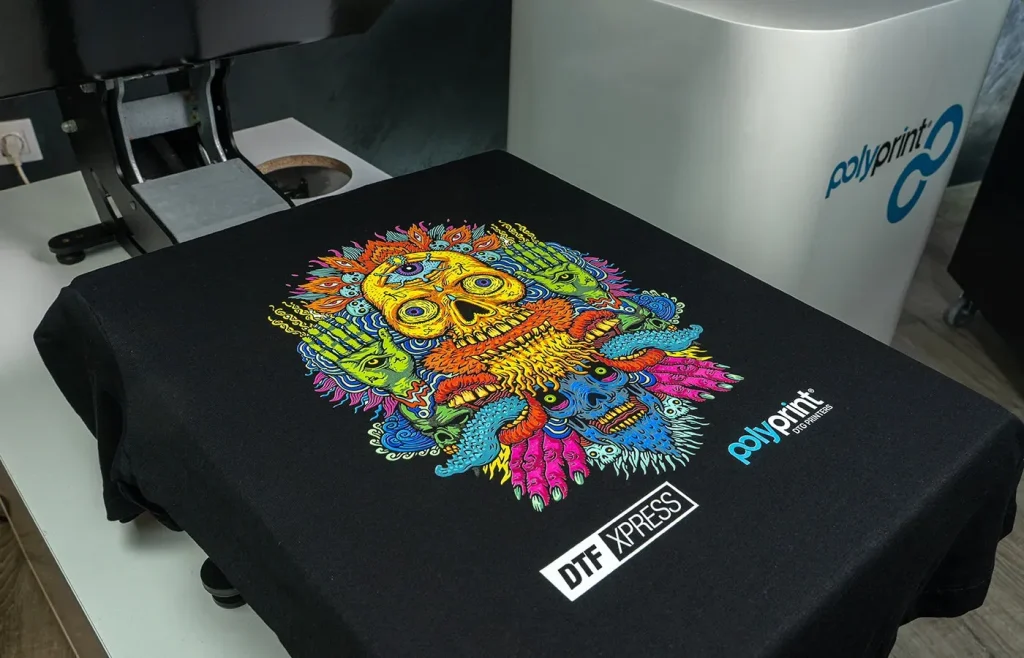DTF printing, or Direct-to-Film printing, has emerged as a groundbreaking technique within the apparel industry, revolutionizing how designs are transferred onto fabric. This innovative printing process combines efficiency with high-quality results, making it an attractive option for both small businesses and larger manufacturers. With its ability to produce vibrant colors and intricate patterns, DTF printing technology is rapidly gaining popularity as a preferred method for high-quality apparel printing. As sustainability becomes a key focus in fashion, the benefits of DTF printing, including reduced waste and the use of eco-friendly materials, contribute significantly to its growing adoption. In the following article, we will uncover five compelling reasons why DTF printing is profoundly impacting the apparel landscape.
In the ever-evolving fashion market, Direct-to-Film (DTF) printing has taken the spotlight as an innovative solution for modern apparel production. Often described as a transformative printing technique, DTF printing opens the door to a sustainable approach that blends creativity with advanced technology. This process not only enhances the quality of printed designs but also aligns with the industry’s shift towards more environmentally friendly practices in garment manufacturing. Utilizing cutting-edge DTF printing methods, brands can produce intricate and customized apparel, responding swiftly to market trends. As we explore the various facets of this printing technology, it becomes clear why it is resonating with designers and consumers alike.
Understanding DTF Printing Technology
Direct-to-Film (DTF) printing technology represents a paradigm shift in the way apparel is printed, providing a more effective approach to garment customization. Unlike traditional methods, which often rely on complex processes involving screens and multiple layers, DTF printing streamlines this workflow by utilizing special films that transfer designs directly onto fabrics. This approach not only enhances quality but also significantly reduces production times, allowing businesses to respond quickly to market trends and consumer demands.
Moreover, DTF printing leverages advanced technological innovations that ensure vibrant, high-quality designs are replicated with precision. The process involves printing the desired image onto a film, applying a special adhesive, and then transferring the design onto the fabric using heat. This method enables the use of a wide range of fabrics, including cotton, polyester, and even blends, making it a versatile choice for diverse applications in the fashion industry.
The Eco-Friendly Advantage of DTF Printing
In an era where sustainability is at the forefront of consumer preferences, DTF printing stands out as a beacon of eco-friendliness within the apparel industry. Traditional printing methods often consume large amounts of water and energy, contributing to environmental degradation. In contrast, DTF printing significantly reduces these resources, utilizing less water and recyclable materials during the printing process. This shift not only helps brands minimize their carbon footprints but also appeals to environmentally conscious consumers who are increasingly seeking sustainable products.
Furthermore, the inks used in DTF printing are typically water-based and free of harmful chemicals, further enhancing its position as a sustainable choice for apparel production. Brands that adopt DTF technology not only comply with regulations but also actively promote their commitment to environmental stewardship, building stronger connections with eco-aware customers. By prioritizing sustainable practices like DTF printing, manufacturers not only benefit the planet but also tap into a growing market segment that values ethical production.
Accessibility of DTF Printing for Small Businesses
One of the most revolutionary aspects of DTF printing technology is its increased accessibility for small businesses and independent entrepreneurs. Previously, high-quality printing solutions were often beyond the reach of smaller companies due to costs and complexity. However, with user-friendly DTF printers readily available, anyone can now create stunning designs without the need for extensive technical expertise.
This democratization of technology encourages creativity and innovation among small business owners, allowing them to compete in the market with established brands. Easy-to-use DTF printing systems enable entrepreneurs to explore custom apparel designs with minimal investment while delivering professional-quality products. As a result, we are witnessing a surge in independent brands that can leverage DTF technology to carve out unique niches in the apparel market.
The Growing Demand for DTF Technology
The rising demand for DTF printing is a clear indicator of its potential within the apparel industry. Investment from key players, like EazyDTF, showcases a robust belief in the viability of DTF technology as a sustainable and commercially viable option. Companies are increasingly recognizing the advantages of DTF printing, not only in terms of efficiency but also in producing high-quality outputs that meet contemporary consumer expectations.
As more manufacturers adopt DTF printing, they can respond more swiftly to fashion trends and consumer preferences, ensuring that they remain competitive in a fast-paced industry. This evolving landscape ensures that DTF technology is not just a passing trend but is instead poised for long-term growth, supported by continuous innovations that enhance its capabilities.
High-Quality Output from DTF Printing
One of the most significant benefits of DTF printing is its ability to produce high-quality outputs that exceed expectations in the apparel industry. This printing technique allows for intricate designs rich in detail and vibrant colors, catering to the aesthetic demands of today’s fashion-conscious consumers. By utilizing state-of-the-art printheads and materials, DTF technology ensures that every piece has striking visual appeal, whether it is a basic graphic tee or an elaborate custom design.
Additionally, the durability of prints achieved through DTF is commendable, boasting resistance to fading and cracking, which is often a concern with other printing methods. The ability to maintain high quality in both speed and volume makes DTF printing an essential asset for businesses striving to meet customer satisfaction and maintain a competitive edge in the bustling apparel market.
Versatility and Application of DTF Printing
DTF printing shines in its versatility, making it applicable across a wide range of apparel items—from t-shirts and hoodies to sports jerseys and fashion accessories. The technology’s adaptability allows designers and brands to explore various fabrics and styles, catering to diverse consumer preferences. This design flexibility is a game-changer for the apparel industry as it empowers manufacturers to quickly pivot their offerings based on trends and customer demands.
As the market and fashion landscape continue to evolve, the versatility inherent in DTF printing becomes increasingly valuable. Manufacturers can efficiently create custom pieces for limited-edition collections, bulk orders for promotional events, or personalized items for individual consumers. This capability ensures that DTF printing remains an essential tool for creativity, enabling the exploration of innovative designs that resonate with audiences while meeting diverse marketplace needs.
Frequently Asked Questions
What is DTF printing and how does it work?
DTF printing, or Direct-to-Film printing, is a state-of-the-art printing technique that transfers designs onto apparel using high-quality film and adhesive. The process involves printing an image onto a special transfer film, applying adhesive powder, and then heat-pressing the design onto the fabric. This method is renowned for its ability to produce vibrant and intricate designs on various materials.
What are the benefits of DTF printing for sustainable apparel production?
DTF printing offers several benefits for sustainable apparel production. Its eco-friendly process significantly reduces water and energy consumption compared to traditional printing methods. Additionally, DTF technology minimizes waste associated with ink usage, appealing to environmentally conscious consumers and brands committed to sustainable practices.
How does DTF printing technology compare to traditional printing methods?
DTF printing technology surpasses traditional methods by offering superior quality and versatility. Unlike screen printing, which requires extensive setups, DTF printing allows for quick and efficient production of detailed designs. It also works on a wide range of fabrics, making it a more adaptable option for manufacturers focusing on high-quality apparel printing.
Is DTF printing accessible for small businesses and individual designers?
Yes, DTF printing is highly accessible for small businesses and individual designers thanks to user-friendly systems that simplify the printing process. Recent advancements, including affordable DTF printers, have lowered the barrier to entry, enabling aspiring entrepreneurs to create custom apparel without needing extensive technical knowledge.
What types of garments can I print using DTF printing?
DTF printing technology offers remarkable versatility, allowing it to be used on various garments, including t-shirts, hoodies, jerseys, and even bags. Its ability to print on diverse materials further enhances its applicability, accommodating customization preferences in both limited edition designs and bulk orders.
How does DTF printing ensure high-quality output?
DTF printing ensures high-quality output by utilizing advanced printheads and specialized inks that create vibrant, durable designs. This technology allows for fine detail and color accuracy, making it ideal for brands aiming to meet the high standards of today’s consumers in the competitive apparel industry.
| Key Point | Explanation |
|---|---|
| Eco-Friendly Production | DTF printing reduces waste in ink, water, and energy compared to traditional printing methods, appealing to sustainability-focused consumers. |
| Accessibility of Advanced Technology | User-friendly DTF systems allow small businesses and individuals to enter the custom apparel market with ease. |
| Expanding Market Demand for DTF Technology | Investments in DTF tech, like those by EazyDTF, signal high market confidence and demand for efficient DTF services. |
| High-Quality Output | DTF printers produce vibrant, intricate designs at speed, meeting the standards of the competitive apparel market. |
| Versatility in Application | DTF printing can be used for various apparel designs and materials, catering to diverse customer preferences. |
Summary
DTF printing is revolutionizing the apparel industry with its unique blend of eco-friendliness, accessibility, and high-quality results. As a method that prioritizes sustainability, it allows brands to produce with less waste, while also encouraging creative entrepreneurship among small businesses and individuals. The growing market demand for DTF technology, evidenced by substantial investments, highlights its viability and potential for future expansion. Moreover, the versatility of DTF printing enables a broad range of applications, making it an attractive choice for designers. As the industry continues to evolve, those who embrace DTF printing will be well-positioned to lead in innovation and meet the dynamic needs of consumers in the fashion landscape.



